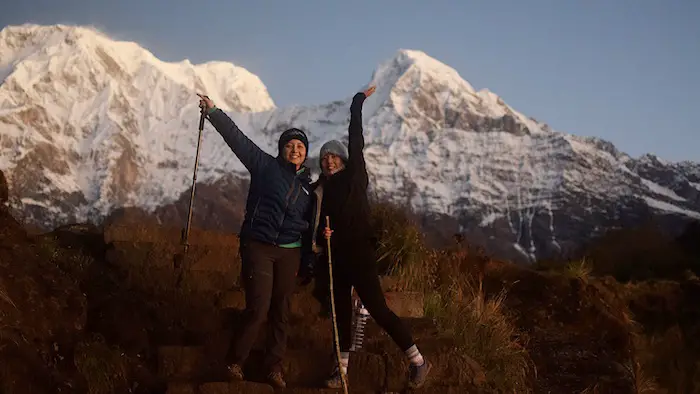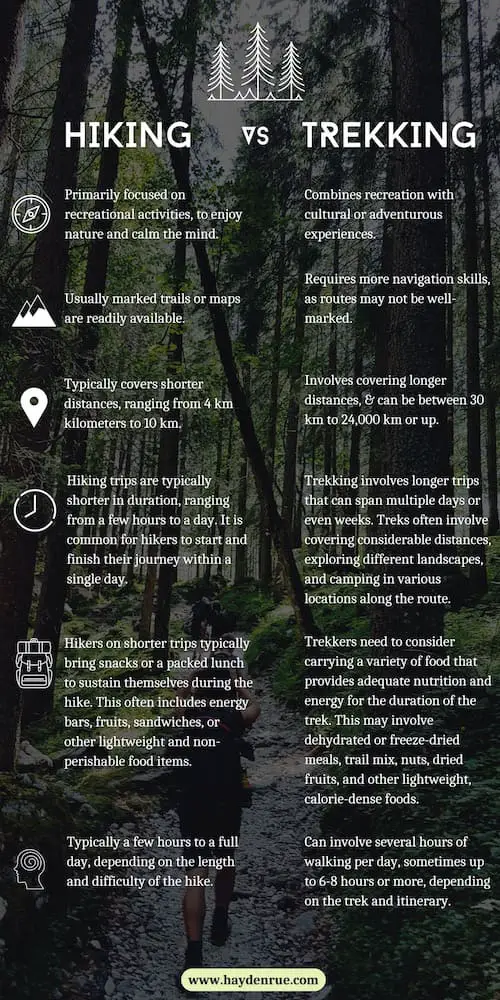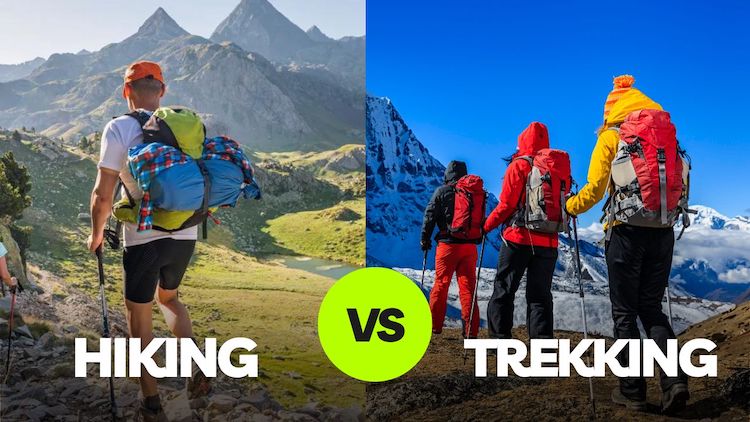Outdoor activities have long captivated adventure enthusiasts and nature lovers alike. Among the most popular activities are hiking and trekking. However, these terms are often used interchangeably, leading to confusion. In this blog, we aim to shed light on the conversation of hiking vs trekking and how they differ.
We will also give you information about how to plan and prepare for each, the difference in terrain and difficulty, and the different gear you will need for each activity. Without further ado, let’s dive right into hiking vs trekking what is the difference?
What is the difference: hiking vs trekking?
The key difference between hiking and trekking is that hiking involves shorter trips on well-established, marked trails, making navigation easier, while trekking takes place in untamed nature with challenging terrains and requires longer journeys, and continuous walking until reaching the destination.
Below you can see a table that summarizes the difference between hiking vs trekking.
| Hiking | Trekking | |
|---|---|---|
| Definition | Leisurely walking on established trails | Adventurous journey in remote areas with diverse terrain |
| Duration | Can be a few hours to a full day | Typically lasts multiple days or even weeks |
| Difficulty | Varied difficulty levels, including easy to moderate | Often more challenging with rugged and steep terrains |
| Infrastructure | Trails with marked signs and facilities | Wilderness with limited infrastructure |
| Equipment | Basic gear like comfortable shoes and daypack | Specialized gear such as backpacks, tents, and boots |
| Camping | Rarely involves overnight stays | Often involves camping along the trekking route, or tea houses |
| Remote Locations | Mostly accessible and closer to urban areas | Takes place in remote and secluded wilderness areas |
| Guided Expeditions | Does not require a guide or porter | Often undertaken with experienced guides or porters |
| Cultural Experience | Limited cultural immersion | Opportunities to interact with local communities |
| Time Commitment | Suitable for day trips or short outings | Requires more time commitment due to longer durations |
| Physical Challenge | Moderate physical exertion | Higher physical demands and endurance required |
| Scenery | Can showcase beautiful landscapes and nature | Provides breathtaking views and diverse natural beauty |
The table depicts the main differences between trekking and hiking. However, many people still use these terms interchangeably. Therefore, we should further define both of the terms.
What is Hiking?

Hiking is a recreational activity that involves walking in natural environments, typically on established trails or paths. It is a popular outdoor activity that allows individuals to enjoy and explore the beauty of nature while engaging in physical exercise. Hiking can range from leisurely walks on gentle terrain to more challenging uphill climbs, providing opportunities for both relaxation and adventure.
Hikes are usually day trips, making them accessible to beginners and people of all ages. You can discover breathtaking landscapes and iconic destinations by embarking on a hiking adventure. If you’re new to the activity, or looking to get started, check out our blog covering backpacking for beginners.
Hiking: Deep Dive into the Activity:
To further understand how hiking and trekking differ from each other, I have summarized some important defining factors for each. Let’s start by looking at hiking.
Hiking Conditions:
Embark on a lengthy and invigorating walk through breathtaking natural surroundings, traversing hiking trails that showcase stunning scenic beauty. While it may present some challenges, certain sections of the trails offer varying difficulty levels to suit your preference.
Duration:
The duration of a hike is usually over a few hours, up to a single day. Hiking is rarely carried out over multiple days.
Distance Covered:
The distance covered can range from 3 to 50 km (2 to 30 mi), with a diverse selection of trails catering to different levels of difficulty.
Essentials to Bring:
For a day hike, ensure you carry a day pack containing water, food, and snacks. If you plan to stay overnight or extend your journey, equip yourself with a larger backpack housing additional clothing, sustenance, water, a tent, and a sleeping bag. Alternatively, you may opt for a backpack with a detachable day pack if you establish a camping base, allowing you to conveniently bring your essentials without carrying your entire load.
Backpack Size Recommendations:
- For a day hike, a lightweight backpack of approximately 15-20 liters is recommended, featuring multiple compartments to keep your belongings within reach.
- For overnight hikes, seek a backpack with a capacity of around 25-35 liters, boasting good ventilation and padded hip belts for added support.
- For multi-day hikes, opt for a backpack ranging from 40-50 liters, providing ample space for camping gear and cooking equipment.
Prominent Hiking Example:
The Inca Trail in Peru, which is famous for its historical significance and breathtaking views of the Andes Mountains. This iconic hiking route spans approximately 43 kilometers (26 miles) and typically takes hikers about four days to complete. Along the way, adventurers have the opportunity to explore ancient Inca ruins, including the remarkable Machu Picchu. The Inca Trail provides a remarkable blend of cultural immersion, natural beauty, and a memorable trekking experience.
What is Trekking?

Trekking refers to a more intensive and adventurous form of outdoor activity that involves multi-day journeys through remote and often challenging terrains. Unlike hiking, trekking takes individuals off the beaten path and may require navigating through rugged mountains, dense forests, or other wilderness areas.
It often includes camping overnight, carrying necessary gear and supplies, and covering longer distances compared to traditional hikes. Trekking requires a higher level of physical fitness, stamina, and self-sufficiency, making it suitable for those seeking longer and more immersive outdoor experiences.
Trekking takes outdoor exploration to a more intense level. For those seeking a thrilling experience and an opportunity to immerse themselves in nature, trekking is an ideal choice. If you are looking for the ultimate trekking challenge, check out the best treks in Nepal!
Trekking: Deep Dive into the Activity:
To continue the conversation about the defining factors of trekking and hiking, let’s take a look at trekking now.
1. Trekking Conditions:
Embark on challenging expeditions that take you through rugged terrains, inclement weather, steep slopes, and potentially high-altitude regions with reduced oxygen levels. Unlike conventional hikes, treks occur in wilderness areas without a designated path, often necessitating specialized training.
2. Trekking Durations:
Treks can span anywhere from a week to several weeks. Throughout the journey, camping becomes a regular practice, and the trek concludes upon reaching the intended destination, or earlier if the conditions become excessively challenging.
3. Distance Covered:
Treks encompass a range of 50 to 1,000 km (30 to 600 mi). For instance, the round-trip trek to the Everest Base Camp in Nepal covers approximately 130 km (80 mi) and typically lasts around 14 days. On certain treks, a daily average of about 10 km (6 mi) is common.
Essentials to Bring:
Given the remote and untamed nature of the environment, it is crucial to carry location-specific equipment to tackle varying conditions. For instance, snow-laden terrains may necessitate ice axes, while deserts require additional hydration measures. Most treks require essential items such as water, food, cooking equipment, a tent, a sleeping bag, appropriate clothing, medication, navigational equipment, and good hiking boots or shoes. Comfortable shoes or boots are essential to keeping your feet happy during the long walk. Check out our blog on how to choose the right trekking and hiking boots.
Recommended Backpack Size:
When selecting a backpack for treks, consider options ranging from 60-85 liters, offering sufficient space for storing essential supplies, including food, clothing, cooking gear, a tent, a sleeping bag, and more. Look for lightweight backpacks with proper ventilation and padded hip belts to alleviate strain on your back.
Prominent Trekking Example:
The Annapurna Circuit Trek in Nepal stands as a prominent example of a captivating and challenging trekking experience. This renowned route takes adventurers on a breathtaking journey around the Annapurna massif, offering stunning views of snow-capped peaks, cascading waterfalls, and lush valleys. Spanning approximately 230 kilometers (140 miles), the trek usually takes around 15 to 20 days to complete.
Key Differences between Hiking and Trekking:

Now let’s take a look at the key differences between the two types of outdoor activities: trekking and hiking.
1. Duration and Distance:
Hikes are typically shorter in duration and cover shorter distances, often completed within a day. They allow you to enjoy a refreshing nature walk or a moderate trail adventure.
When it comes to trekking, the activity involves longer journeys that span multiple days or even weeks. Trekking requires a higher level of commitment and endurance as you traverse through challenging terrains.
2. Terrain and Difficulty:
Hiking usually takes place on established, marked trails with moderate terrains, making it accessible to a wide range of fitness levels.
Trekking, on the other hand, often involves off-trail navigation, steep ascents and descents, and encounters with diverse landscapes. It demands a higher level of physical fitness and skill, as you navigate through rugged mountains, dense forests, or remote wilderness areas.
3. Gear and Equipment:
When it comes to hiking, a comfortable pair of shoes, a water bottle, and a backpack are usually sufficient. However, trekking requires additional gear, such as tents, sleeping bags, cooking equipment, and navigation tools. Make sure you also have the right backpack, as ensuring you have the best trekking or hiking backpack will make sure you have a comfortable and sustained walk throughout your trip.
Packing light yet essential items is crucial for long-distance treks. Creating a backpacking checklist will help ensure you have all the necessary equipment for a successful journey.
4. Level of Fitness and Skill:
Hiking is a versatile activity that can be enjoyed by people of various fitness levels and ages. Whether you prefer a leisurely walk or a more challenging uphill adventure, there is a hiking trail suitable for everyone.
Trekking, on the other hand, demands higher levels of physical fitness, stamina, and endurance. It may also require navigational skills, survival knowledge, and camping experience. Before embarking on a trekking adventure, it’s important to assess your fitness level and acquire the necessary skills.
Benefits of Hiking and Trekking:

Both hiking and trekking offer numerous benefits for your physical and mental well-being. They provide opportunities to connect with nature, reduce stress, and rejuvenate your mind and body. Hiking allows you to enjoy the beauty of nature while engaging in a moderate level of physical activity. Trekking, with its longer duration and more demanding challenges, offers a chance for personal growth, self-discovery, and building resilience.
1. It Lowers The Risk Of Heart Disease And Improves Your Blood Pressure:
Engaging in regular hiking not only offers enjoyable outdoor activities but also contributes to reducing the risk of heart disease and improving blood pressure. The physical exertion involved in hiking helps strengthen the heart muscle, enhance cardiovascular fitness, and promote better blood circulation. By consistently challenging the body’s cardiovascular system, hiking can help lower the risk of developing heart-related ailments and maintain healthy blood pressure levels.
2. Better Overall Fitness:
Hiking is a fantastic way to improve overall fitness as it engages various muscle groups and promotes physical endurance. The uneven terrain, inclines, and descents encountered during hiking require the body to adapt and respond, resulting in improved strength, flexibility, and balance. Uphill climbs work the lower body muscles, including the legs, glutes, and calves, while downhill sections engage different muscles, such as the quadriceps and stabilizing core muscles. Additionally, the act of carrying a backpack adds an extra element of resistance, further enhancing muscular strength and endurance.
3. Improves Your Mental Health:
One of the significant benefits of hiking lies in its positive impact on mental health. Immersion in nature, away from the hustle and bustle of daily life, provides a welcome respite for the mind. The tranquil and serene environment, coupled with physical activity, helps reduce stress levels and promotes relaxation. Hiking also stimulates the release of endorphins, known as the “feel-good” hormones, which can uplift mood and alleviate symptoms of anxiety and depression. Moreover, the rhythmic movement and focus required during hiking can foster a meditative state and promote mindfulness, enhancing overall mental well-being.
4. Hiking And Trekking Burns Calories:
In addition to its numerous health benefits, hiking and trekking are effective calorie-burning activities. The combination of uphill climbs, varied terrains, and extended durations of physical exertion contribute to a significant energy expenditure. Hiking at a moderate intensity can burn a substantial amount of calories, aiding in weight management and promoting a healthy metabolism. Furthermore, the continuous movement and engagement of multiple muscle groups during hiking contribute to increased energy expenditure even after the activity is completed.
5. It Makes You Creative:
The connection between nature and creativity has long been recognized, and hiking provides an ideal opportunity to foster inspiration and stimulate creativity. Being immersed in natural surroundings, away from distractions and surrounded by awe-inspiring landscapes, can unlock the mind’s creative potential. The tranquility, beauty, and serenity of nature serve as a catalyst for innovative thinking and problem-solving. Hiking offers a chance to disconnect from the digital world, engage with the senses, and tap into the limitless wellspring of creativity within us.
Hiking vs Trekking: What is the Difference Between the two:
Understanding the differences between hiking and trekking is essential for choosing the right outdoor adventure.
Hiking offers accessible leisure and exploration on marked trails, suitable for beginners and individuals of all fitness levels. Trekking, with its more intense and multi-day nature, provides an opportunity for thrilling journeys through challenging terrains.
Both activities offer unique experiences and benefits, so whether you opt for a leisurely hike or an epic trek, the key is to embrace the outdoors and discover the beauty of nature at your own pace. Remember to equip yourself with the best trekking and hiking gear and make sure you know how to plan for your backpacking trip no matter which type of activity you are going on.
FAQs: Hiking vs Trekking – Know how they differ
Below are some of the most frequently asked questions regarding the conversation around hiking vs trekking and how they differ.
Typically, hiking is shorter than trekking. Hiking trails span from just a few miles to several thousand miles. Treks are at least 30 miles (50 kilometers) long, but they can extend to an impressive 15,000 miles (24,000 kilometers) or beyond.
Hiking involves embarking on a lengthy walk, while trekking entails undertaking a challenging and demanding long hike. Climbing entails using both legs and sometimes hands to ascend a surface or structure.
Each hiker and trail has its own unique characteristics, but typically, an average hiker can cover a distance of 8-15 miles per day. Even hikers with a slower pace can still achieve significant distances given sufficient time. For instance, maintaining a leisurely pace of 2 mph (slower than the average), one can comfortably hike 10 miles in a day.
The similarities between hiking and trekking: they are both outdoor activities that revolve around walking in natural surroundings. They offer benefits for enhancing physical fitness and promoting mental well-being. Both activities can be enjoyed alone or in the company of others. However, trekking generally involves larger groups compared to hiking.
